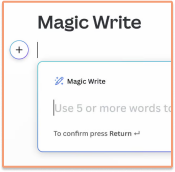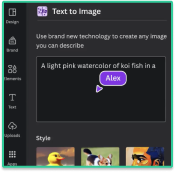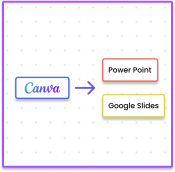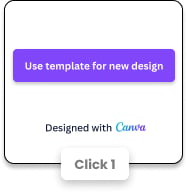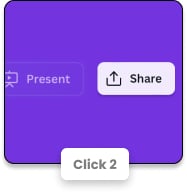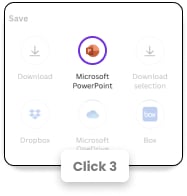In a world of big data, visual communication is a vital skill to have.
Being able to present an easy-to-understand, visual version of all those facts and figures is essential to a growing number of jobs.
Add in a pandemic and our new working from home culture, and the ability to convey information in a visual format has never been more important.
Talking online, we can’t rely on the usual gestures, cues or props. Visual content can fill that gap, helping us to convey our message to better effect.
Whatever your industry or your department, there’s a lot to be gained from good visual communication:
- Sales teams can use it to create emotive presentations that close more deals.
- HR can improve internal communications.
- Training teams can develop more effective instructional materials.
- Marketers can create visual presentations that better engage their customers.
All of this is possible when you master visual communication strategies.

- So, what is visual communication?
- Why is visual communication important?
- How to use visual communication to raise your presentation game
- Use images and icons
- Use visual metaphors
- Master the use of color
- Use geometric shapes
- Use charts and graphs
- Convert complex explanations into diagrams and infographics
- Create the right mood with typography
- Try using GIF and video
- How to get started with communication design
So, what is visual communication?
Visual communication means sharing ideas using visual elements as well as speech and text. We’re talking images, graphs, videos, infographics, and so much more.
Just imagine: if someone speaking to you reeled off a bunch of statistics, it would be very hard to put those figures into context.
Now, if that same person had a beautifully designed graph or infographic to illustrate their data, it would be much easier to understand and make sense of the numbers you were being presented with.
This is visual communication.

Why is visual communication important?
Because it has a number of really important benefits for audiences, presenters and brands.
It’s easier to process
Words are obviously essential to our communication. But they’re abstract. Our brains find it much easier to process images.
In fact, studies have shown that when text is accompanied by visuals, it improves audience memory and understanding of that text by 36%.
It’s good at creating emotion
Visuals reach your audience at a subconscious level. Color, images and other design elements evoke a range of different emotions. Pick the right ones and you can really drive home your message.
It makes content more accessible
Not everyone is a whizz when it comes to complex words and numbers. A visual presentation offers an alternative (and more accessible) way to convey information and data.

How to use visual communication to raise your presentation game
So what are the best ways to employ it? How can you better engage with your audience? And what visual communication strategies can you apply to your PowerPoints right now?
Here are a number of tips and tricks that will help you to improve your visual communication game:
Use images and icons
A picture speaks a thousand words. It’s a cliché. But it’s nonetheless very true. When you incorporate images and icons into your presentation slides, you can really cut down your word count.

Use images to illustrate a technical process. Summarize a paragraph of text with a preceding icon. Show rather than tell your audience what you want them to know.
Images and icons are the best tools to create a communicational shortcut — a quick and easy way to convey your message. They also never fail to engage an audience.
Use visual metaphors
Being literal isn’t always the best approach. A metaphorical image has the power to create emotion and to get your audience thinking.

So it pays to think outside the box when you’re choosing images to accompany your text.
When looking for or creating images, think of abstract concepts — like creativity or wanderlust. Images that represent abstract concepts are much more likely to inspire and engage your audience.
Master the use of color
Color is an essential part of any presentation. When it can be used to such great effect, it’s just plain silly to leave your presentation color palette on its default setting.
Learn the basics of color theory and you’ll discover that every color produces some kind of emotional response or subconscious association in a viewer. And that bright colors can create particularly powerful emotional responses amongst your audience.

Use this knowledge to your advantage! Add color that helps to convey your message. Or refocus an audience’s attention.
Also, remember — color is important but there’s no need to use overly complicated or busy color palettes. A simple but colorful background or a colorful title text can make all the difference.
Use geometric shapes
Geometric shapes — like circles, triangles and hexagons — can be put to a number of different uses in your presentation.
You can use shapes to group related text together. Then, by adjusting the size, color and outline of a shape, you can draw attention to key information first. A bold outline or a contrasting color, will set that information block apart from the rest of the slide.
You can also use shapes — in the form of lines and borders — to indicate the relationship or flow between different ideas. This all helps to convey concepts quickly, without lots of additional explanation from you!

Shapes will help to organize the information you’re presenting. But they also speak to an audience on a subconscious level:
- Squares and rectangles convey strength and stability
- Triangles draw the eyes upwards and suggest direction
- Circles represent completion and harmony
If you’re feeling creative, you can also use exaggerated and asymmetrical shapes to create an even more striking visual effect.
Use charts and graphs
Stats, numbers and quantitative evidence create trust amongst your audience. The information you convey is important. But so is the design of your charts and graphs.
When it comes to presenting your data, it shouldn’t look like you’ve just lifted it from your Excel spreadsheet.
Instead, you should:
- Analyze the data and use it to tell a story
- Get rid of data that doesn’t illustrate your point
- Emphasize anything that’s particularly meaningful so people get the key insights

You can then customize the appearance of your data. Colors should fit with your overall scheme. Any text should be legible. Both PowerPoint and Google Slides have the tools to make graph customization easy-peasy.
This will all help your audience to understand context and discern patterns within the data. It will also make your figures much more memorable.
Convert complex explanations into diagrams and infographics
Long, text-based explanations aren’t helpful. They can be daunting to a reader. And difficult to digest.
So what’s the visual alternative? Diagrams and infographics can be used to convey complex ideas, information and processes. And they do it really well!

Audiences find it easier to make sense of information and later remember it when it’s presented to them in one of these visual formats. They get both the big picture and the most important details too.
What’s more, the internet loves a useful and well-designed infographic. Feature it on your presentation but — wherever relevant — share it on the web too. Great visual communication like this will draw attention to your brand.
Create the right mood with typography
Good visual communication extends way beyond images and charts. The fonts you choose also create a visual impact. Just think of all the different typography you see in company logos. A typeface can communicate so much!

So choose a font that complements your presentation narrative. Here’s a quick rundown of some better-known typefaces:
- Serif fonts are generally classy and elegant
- Sans serif fonts are modern, informal and sometimes a little bit techy
- Handwritten fonts help to give a personal touch — but avoid especially flouncy ones. They’re sometimes completely unreadable!
- Soft, round fonts convey a friendly and approachable tone
Play around with fonts and you’ll get to know which ones fit your context and your audience best.
Try using GIF and video
The human eye is drawn towards movement. That’s why videos and GIFs attract our attention so easily!
Moving images work really well in presentations, as long as they’re used sparingly and in the right context.
GIFs are informal and often humorous. If you know your audience well, they can be used to illustrate a point or highlight an idea in just seconds.

Short videos (around 30 seconds) are also really great at conveying lots of information in a short space of time. From showing how a product works to filmed testimonials to a guided tour — a video can say so much — without you having to say a word!
How to get started with communication design
If you don’t happen to have a graphic design background, you might be wondering just how you’ll put these design principles into practice.
Whilst it’s often easier than you think, a professional presentation template can really set you off on the right foot. And help to avoid long hours spent slogging over your presentation.
Using a PowerPoint template or Google Slides template means you don’t have to start from scratch. Browse our presentation template library and you’ll find lots of excellent examples of visual communication strategies at work. Our templates combine color, font, shape, image and chart best practice.
Just pick a professional template, add in your text, then customize as much or as little as you like. Whatever your approach, with a SlidesCarnival template, your presentation design is sure to be on point.


